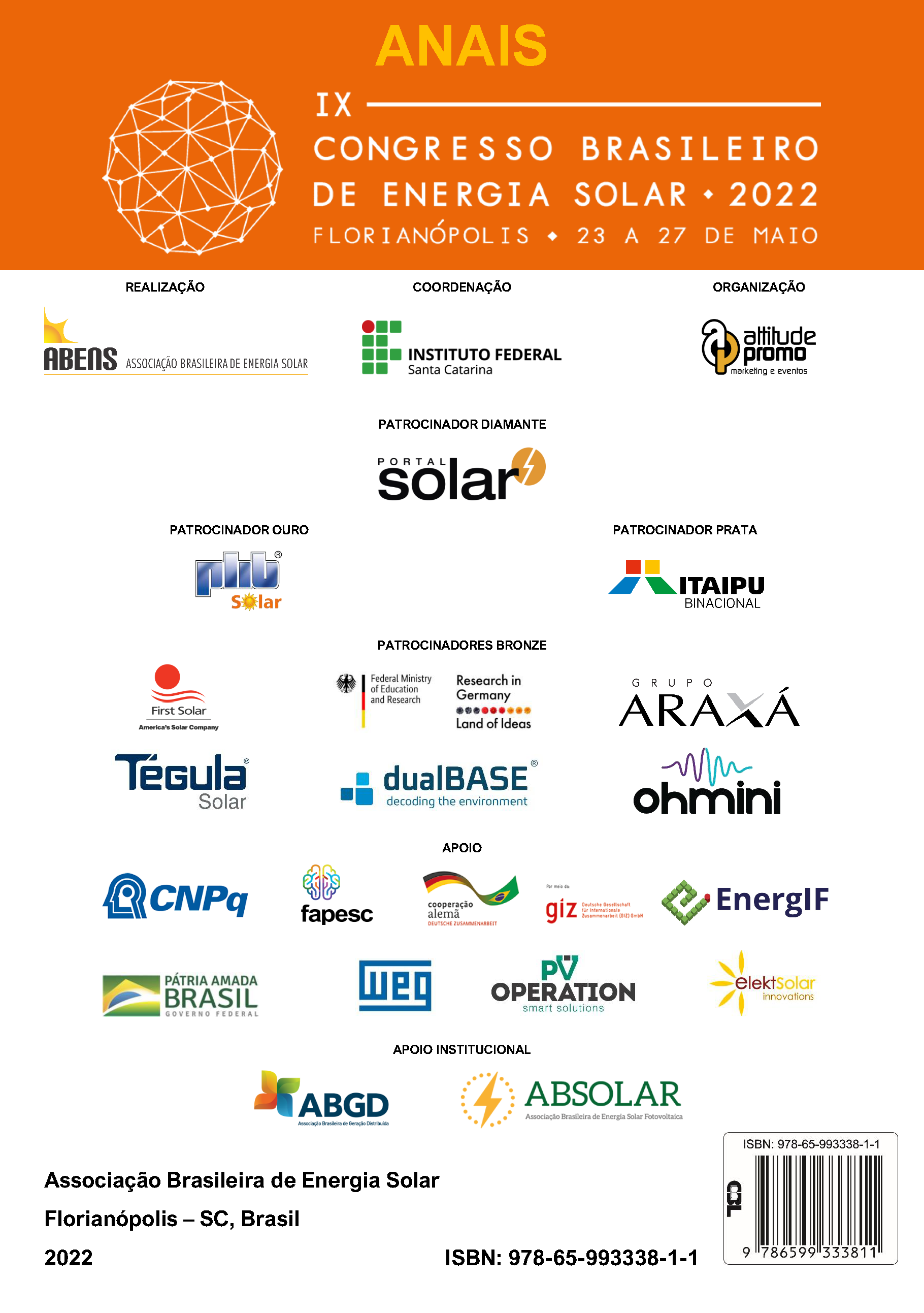SITE ADAPTATION
METHODS AND CASE STUDY FOR FLORIANÓPOLIS-SC
DOI:
https://doi.org/10.59627/cbens.2022.1178Keywords:
Site adaptation, solar irradiance, satellite dataAbstract
For local analysis, solar resource is best evaluated by ground measured meteorological stations. However, when the distance to the nearest station is high, satellite-based data (historical data series) become the ideal solution, especially for regional and continental analysis. Although satellite-based methods have high levels of confidence, they can still show significant differences when compared to instantaneous values measured on the ground. In order to ensure the reliability of on-site PV generation results, satellite data correction methods known as site adaptation, using ground-measured data, have been implemented. The purpose of these methods is to minimize the error and improve the deviation between satellite-derived data and instantaneous ground measurements. The objective of this work is to present the application of the linear regression site adaptation method for data measured in the meteorological station of the Laboratory Fotovoltaica/UFSC. Additionally, complements of this method were applied by dividing the data into days with clear and cloudy skies and later by irradiance bands. It was observed that the linear regression method would present relative errors of 22.35% (rRMSE) and 1.61% (rMBE). The clear-sky division methodology showed an improvement of 0.1% in the rRMSE and 0.14% in the rMBE. Finally, the methodology of division by irradiance bands presented a result of rRMSE 0.88% worse and an rMBE 0.6% closer to the ideal trend.
Downloads
References
Aguiar, R., Collares-Pereira, M., 1988. A simple procedure for generating sequences of daily radiation values using a library of markov transition matrices. Solar Energy, vol.40, No.3, pp. 269-279.
Aguiar, M. L., Polo, J., Vindel, J.M., Oliver, A. 2019. Analysis of satellite derived solar irradiance in islands with site adaptation techniques for improving the uncertainty. Renewable Energy, Vol. 135, pp. 98-107.
Bright, J.M. 2019. Solcast: Validation of a satellite-derived solar irradiance dataset. Solar Energy, vol. 189, pp. 435-449.
Ineichen, P., 2014. Long term satellite global, beam and diffuse irradiance validation. Energy Procedia, vol. 48, pp. 1586–1596.
Long, C.N., Dutton, E.G. BSRN Global Network recommended QC tests, in: PANGAEA, Bremerhaven, 2010.
Mantelli, S.L., Martins, G.L., Rüther, R. Uncertainty analysis of solar monitoring station: a case study, in: Solar World Congress, Santiago, Chile, 2019.
Mermoud, A. PVsyst: Software for the Study and Simulation of Photovoltaic Systems. 1993-2021.
Mieslinger T., Ament, F., Chhatbar, K., Meyer, R. 2014. A New Method for Fusion of Measured and Model-derived Solar Radiation Time-series. Energy Procedia, Vol. 48, pp. 1617–1626
National Renewable Energy Laboratory - NREL, 2021. Best practices handbook for the collection and use of solar resource data for solar energy applications: Second edition.
Pereira, E. B., Martins, F. R., Gonçalves, A. R., Costa, R. S., Lima, F. J. L. D., Rüther, R., Abreu, S. L. D., Tiepolo, G. M., Pereira, S. V., Souza, J. G. D., 2017. Atlas Brasileiro de Energia Solar, 2ª ed.: INPE. São José dos Campos - SP.
Perez, R., Seals, R., Zelenka, A., 1997. Comparing satellite remote sensing and ground network measurements for the production of site/time specific irradiance data. Solar Energy, vol. 60, pp. 89–96.
Polo, J., Martín, L., Vindel, J.M. 2015. Correcting satellite derived DNI with systematic a seasonal deviations: Application to India. Renewable Energy, Vol. 80, pp. 238-243.
Polo, J., Wilbert, S., Ruiz-Arias, J.A., Meyer, R., Gueymard, C., Súri, M., Martín, L., Mieslinger, T., Blanc, P., Grant, I., Boland, J., Ineichen, P., Remund, J., Escobar, R., Troccoli, A., Sengupta, M., Nielson, K. P., Renne, D., Geuder, N., Cebecauer, T. 2016. Preliminary survey on site-adaptation techniques for satellite-derived and reanalysis solar radiation datasets. Solar Energy, Vol. 132, pp. 25-37
Polo, J., Fernández-Peruchena, C., Salamalikis, V., Mazorra-Aguiar, L., Turpin, M., Martín-Pomares, L., Kazantzidis, A., Blanc, P., Remund, J. 2020. Benchmarking on improvement and site-adaptation techniques for modeled solar radiation datasets. Solar Energy, Vol. 201, pp. 469-479.
Ruiz-Arias, J.A., Pozo-Vázquez, D., Lara-Fanego, V., Santos-Alamillos, F.J., Tovar-Pescador, J., 2011. A high-resolution topographic correction method for clear-sky solar irradiance derived with a numerical weather prediction model. Journal of Applied Meteorology and Climatology, vol. 50 (12), pp. 2460–2472.


